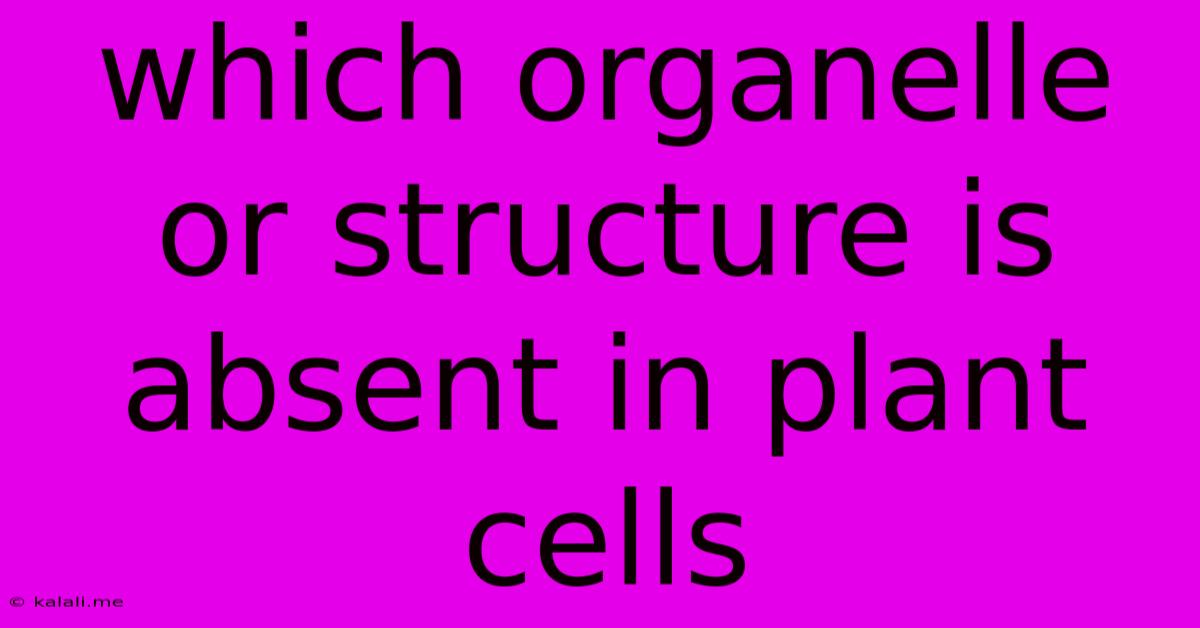Which Organelle Or Structure Is Absent In Plant Cells
Kalali
Jun 16, 2025 · 2 min read

Table of Contents
Which Organelle or Structure is Absent in Plant Cells? A Deep Dive into Cellular Differences
Plant cells and animal cells, while both eukaryotic, exhibit key structural differences that reflect their distinct functions. This article will explore the specific organelles and structures absent in plant cells, focusing on those that are characteristic of animal cells. Understanding these differences is crucial for grasping the fundamental biology of both cell types.
Key Differences: What Plant Cells Lack
The most notable difference lies in the presence of certain organelles crucial for animal cell function but absent in plant cells. These include:
-
Centrioles: These cylindrical structures, composed of microtubules, are involved in organizing the microtubules during cell division, specifically in forming the spindle apparatus. Plant cells achieve spindle formation through other mechanisms, and therefore, lack centrioles. While some plant cells may show centriole-like structures, their function differs significantly.
-
Lysosomes: These membrane-bound organelles contain hydrolytic enzymes that break down waste materials and cellular debris. Plant cells perform similar functions through the vacuole, a much larger and more versatile organelle. The vacuole encompasses many of the lysosome's functions, making dedicated lysosomes redundant.
-
Flagella (in most cases): While some plant cells, particularly motile gametes (sperm cells), possess flagella, the majority of plant cells lack these whip-like structures used for locomotion. Animal cells frequently utilize flagella for motility.
Understanding the Functional Equivalents:
While plant cells lack these specific organelles, their functions are often carried out by other structures. For instance:
-
Vacuoles compensate for lysosomes: The large central vacuole in plant cells plays a critical role in storing nutrients, waste products, and water. Its hydrolytic enzymes contribute to the breakdown of cellular components, mirroring the function of lysosomes.
-
The cytoskeleton handles spindle formation: Plant cells utilize a complex cytoskeleton, including microtubules, to organize the spindle apparatus during cell division, effectively replacing the role of centrioles in animal cells.
Other Structural Variations:
Beyond the absence of specific organelles, there are other structural differences to consider:
-
Cell Wall: Plant cells are characterized by a rigid cell wall, composed primarily of cellulose, which provides structural support and protection. Animal cells lack this external layer.
-
Chloroplasts: Plant cells possess chloroplasts, the sites of photosynthesis, which are responsible for converting light energy into chemical energy. Animal cells lack chloroplasts and obtain energy through consuming other organisms.
Conclusion:
The absence of centrioles, lysosomes, and (in most cases) flagella are key distinctions between plant and animal cells. However, it’s essential to remember that plant cells have evolved alternative mechanisms and structures, such as the large central vacuole and a specialized cytoskeleton, to perform similar functions. These differences reflect the distinct evolutionary paths and physiological requirements of these two fundamentally important eukaryotic cell types. Understanding these variances allows for a more comprehensive appreciation of the diversity and complexity of cellular life.
Latest Posts
Latest Posts
-
A Dekameter Is Equal To 100 What
Jun 16, 2025
-
Which Of The Following Is Not A Form Of Unemployment
Jun 16, 2025
-
Chemical Energy Is Stored In The Between Atoms
Jun 16, 2025
-
What Is The Least Common Multiple Of 16 And 36
Jun 16, 2025
-
What Is The Average Atomic Mass Of Chlorine
Jun 16, 2025
Related Post
Thank you for visiting our website which covers about Which Organelle Or Structure Is Absent In Plant Cells . We hope the information provided has been useful to you. Feel free to contact us if you have any questions or need further assistance. See you next time and don't miss to bookmark.